Portable Audio Recorder Shootout
By Ed Ting
Updated 11/10/07
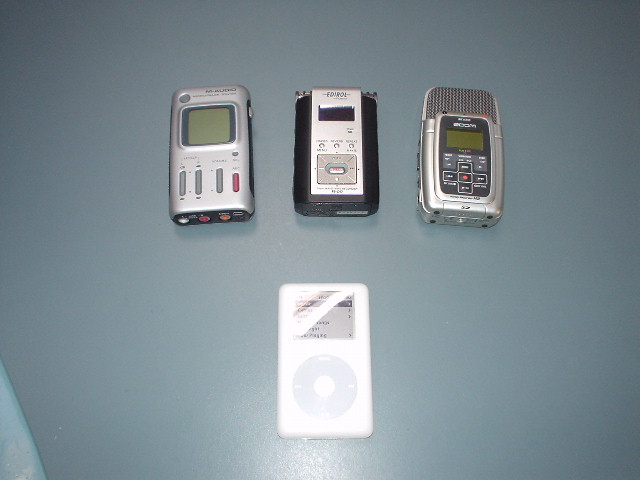 The M-Audio Microtrack, the Roland Edirol, and the Zoom H2
The M-Audio Microtrack, the Roland Edirol, and the Zoom H2
I've been fascinated by recorded audio all my life. When I was a kid, I would figure out ways to record anything - the
rumble of traffic on my street, conversations around the house, and TV shows (Star Trek, of course, was a favorite.) When
M-Audio launched their Microtrack a couple of years ago, I was one of the first people lining up to get one. I was
amazed - A $400 16 bit (or better) digital audio recorder that fit into the palm of my hand! 10 years ago, you couldn't
get any recorder of this type, for any amount of money. What's more, the digital medium allows for easy and
seamless editing, something which was (and I'm being kind here) a real chore with the magnetic tape media of the past.
The Microtrack picked up some competition, and now there are three viable alternatives for portable digital recording.
Roland introduced the Edirol R-09 ($300 street) and Zoom really opened up the price wars with their recently released
H2 ($199 street.) All three recorders have a large array of features (the Zoom even records in surround sound) but as
a lover of quality audio, I wanted to see how their recorded audio compared to one another.
The Devices
The M-Audio Microtrack
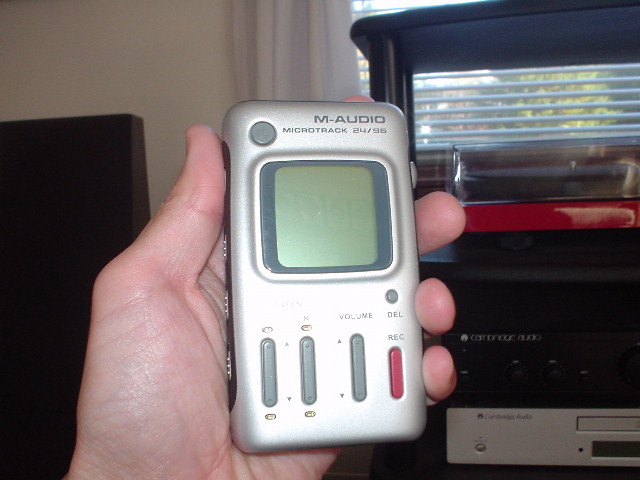 M-Audio's Microtrack ($399 street)
The Microtrack is the simplest of the three devices. The screen is the largest, but there's a lot of wasted real
estate on there, and it doesn't show you any more than the Edirol's or the Zoom's screen. There are four buttons
on the front, and four along the left side. Menus can be reached with the "Nav" rocker switch on the right hand
side. The Microtrack seems to be aimed at a higher-end crowd than the other two - it has RCA jacks for line outs
and 1/4" TRS (Tip Ring Sleeve) inputs for mics at the top (Note: Be sure you don't accidentally apply Phantom Power
to mics that don't need it. The TRS jack looks identical to conventional 1/4" input jacks, but it's not the same.)
The unit takes a while to boot up. And you'd better not be wearing headphones when it does. You'll get an
unpleasant POP in your ears when the firmware finishes booting.
The device records on to Compact Flash cards. To connect to your computer, turn the device off and attach the USB
cord, or leave the unit on with the USB cable attached and connect via the menu. It does not have replaceable batteries,
and this is the source of the most consistent complaints against the device. The batteries, well...they aren't very good.
Mine never seem to stay charged for very long. I get an hour or two worth of use before I start getting nervous. I've
emailed M-Audio about this and they're told me there's pretty much nothing they can do, short of me buying a new one.
The Edirol R-09
M-Audio's Microtrack ($399 street)
The Microtrack is the simplest of the three devices. The screen is the largest, but there's a lot of wasted real
estate on there, and it doesn't show you any more than the Edirol's or the Zoom's screen. There are four buttons
on the front, and four along the left side. Menus can be reached with the "Nav" rocker switch on the right hand
side. The Microtrack seems to be aimed at a higher-end crowd than the other two - it has RCA jacks for line outs
and 1/4" TRS (Tip Ring Sleeve) inputs for mics at the top (Note: Be sure you don't accidentally apply Phantom Power
to mics that don't need it. The TRS jack looks identical to conventional 1/4" input jacks, but it's not the same.)
The unit takes a while to boot up. And you'd better not be wearing headphones when it does. You'll get an
unpleasant POP in your ears when the firmware finishes booting.
The device records on to Compact Flash cards. To connect to your computer, turn the device off and attach the USB
cord, or leave the unit on with the USB cable attached and connect via the menu. It does not have replaceable batteries,
and this is the source of the most consistent complaints against the device. The batteries, well...they aren't very good.
Mine never seem to stay charged for very long. I get an hour or two worth of use before I start getting nervous. I've
emailed M-Audio about this and they're told me there's pretty much nothing they can do, short of me buying a new one.
The Edirol R-09
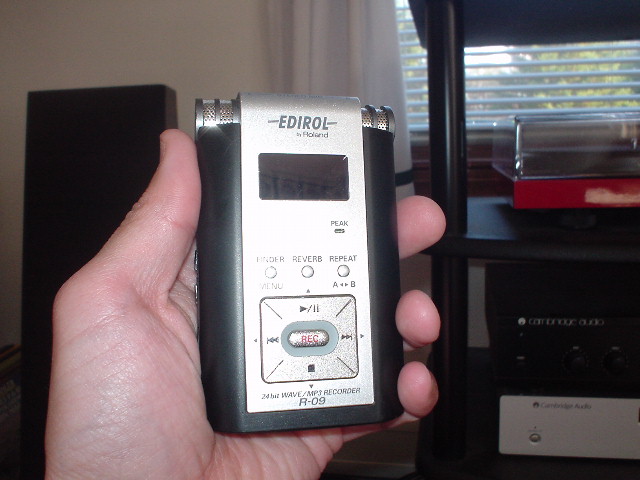 Roland's Edirol R-09 ($299 street)
The Edirol is stylish and sleek little unit. Two built in condensor mics sit across the top of the unit. The device
has switches - a lot of them. There are controls on the front, the back, and on both sides. The latter can be
difficult to access in the dark, since they're black on black. The bottom opens up to reveal an SD card slot, a
USB jack, and a bay for a pair of conventional AA batteries. If you're a Microtrack owner who's struggled with battery
life, you probably just groaned. Roland is going to sell a lot of these due to this feature alone. While making
these recordings, I found it a little inconvenient to keep having to open up the bottom just to gain access to
the USB connector and the SD card. Happily though, the computer recognizes the device immediately and there are
no buttons to push, unlike the other two devices. If you make a lot of recordings and upload a lot, this could be
an important feature for you.
The Edirol has a tiny little screen (the smallest of the three by far) but it tells you what you need to know. It's
got the best contrast, by far. I also like the big blinking red light on the front showing you that you're recording.
Even though I own and use the Microtrack and the Zoom, I found the Edirol to be the most intuitive. Due to these nice
"human" touches, I made the fewest mistakes during my recording sessions with the Edirol.
The Zoom H2
Roland's Edirol R-09 ($299 street)
The Edirol is stylish and sleek little unit. Two built in condensor mics sit across the top of the unit. The device
has switches - a lot of them. There are controls on the front, the back, and on both sides. The latter can be
difficult to access in the dark, since they're black on black. The bottom opens up to reveal an SD card slot, a
USB jack, and a bay for a pair of conventional AA batteries. If you're a Microtrack owner who's struggled with battery
life, you probably just groaned. Roland is going to sell a lot of these due to this feature alone. While making
these recordings, I found it a little inconvenient to keep having to open up the bottom just to gain access to
the USB connector and the SD card. Happily though, the computer recognizes the device immediately and there are
no buttons to push, unlike the other two devices. If you make a lot of recordings and upload a lot, this could be
an important feature for you.
The Edirol has a tiny little screen (the smallest of the three by far) but it tells you what you need to know. It's
got the best contrast, by far. I also like the big blinking red light on the front showing you that you're recording.
Even though I own and use the Microtrack and the Zoom, I found the Edirol to be the most intuitive. Due to these nice
"human" touches, I made the fewest mistakes during my recording sessions with the Edirol.
The Zoom H2
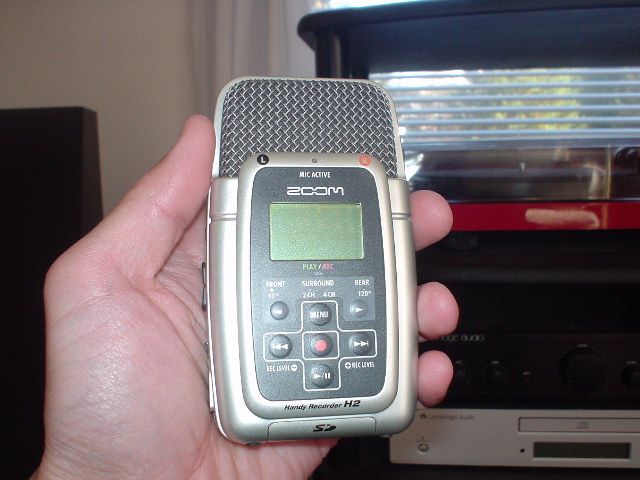 The Do-Everything Zoom H2 ($199 street)
The Zoom H2 is the newest of the three devices. Even though I already own a Microtrack, I bought an H2 the day it came out
due to its amazing array of features and its low price tag ($199 street.) The Zoom's designers were paying attention
when they made the H2. The confusing menu system of the H4 has been cleaned up. It has user replaceable batteries.
It records on an SD card, and its slot, as well as the USB connector port, are easily accessible. The device one-ups the
Edirol by supplying four built in mics. Yes, it will record in surround sound. It comes with a desktop stand, a mic
clip adapter (it's the only one of the three threaded at the bottom) a case, and a giant foam windscreen that works
better than the Microtrack's. If you like to tinker, the Zoom is for you. You can manually rename files, divide files,
normalize levels, and it has a built in mp3 converter. And I've just scratched the surface. You really have to see the
manual. I was shaking my head at all the things it will do. The downside of all this is that you have to poke at a lot
of menus to get at the function you want. When I don't use mine for a couple of months, I still have to look up how to
sync it up with my computer.
The H2's screen is larger than the Edirol's but smaller than the Microtrack's. It's decent. There are switches and jacks
along the left and right sides, and membrane keys on the front. Tiny LEDs let you know which mics are active. A nice
touch - when you turn it off, the display reads "Goodbye See You!"
The Setup
The Do-Everything Zoom H2 ($199 street)
The Zoom H2 is the newest of the three devices. Even though I already own a Microtrack, I bought an H2 the day it came out
due to its amazing array of features and its low price tag ($199 street.) The Zoom's designers were paying attention
when they made the H2. The confusing menu system of the H4 has been cleaned up. It has user replaceable batteries.
It records on an SD card, and its slot, as well as the USB connector port, are easily accessible. The device one-ups the
Edirol by supplying four built in mics. Yes, it will record in surround sound. It comes with a desktop stand, a mic
clip adapter (it's the only one of the three threaded at the bottom) a case, and a giant foam windscreen that works
better than the Microtrack's. If you like to tinker, the Zoom is for you. You can manually rename files, divide files,
normalize levels, and it has a built in mp3 converter. And I've just scratched the surface. You really have to see the
manual. I was shaking my head at all the things it will do. The downside of all this is that you have to poke at a lot
of menus to get at the function you want. When I don't use mine for a couple of months, I still have to look up how to
sync it up with my computer.
The H2's screen is larger than the Edirol's but smaller than the Microtrack's. It's decent. There are switches and jacks
along the left and right sides, and membrane keys on the front. Tiny LEDs let you know which mics are active. A nice
touch - when you turn it off, the display reads "Goodbye See You!"
The Setup
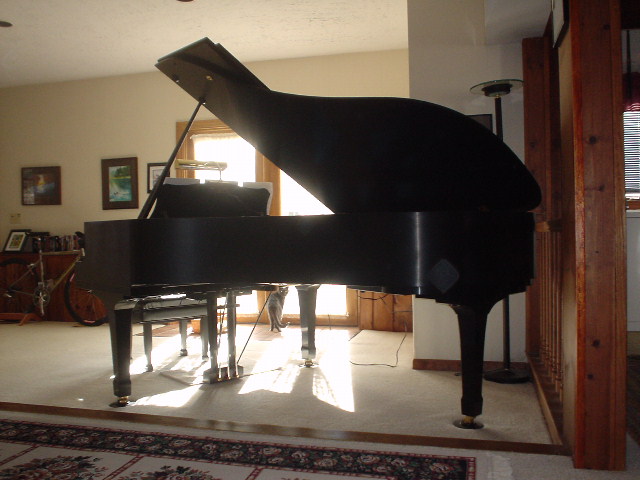 I set up the three recorders near the open end of my piano, a 7 ft 1999 Yamaha C6 parlor grand. If you've listened to my
other mp3s on this site, this is the piano where I do most of my recording. I recorded myself playing a short piece of
music, first using the supplied mics, and then with an external mic setup. My external mics are of high quality - they're
Neumann KM184s, and they're fed into a Symetrix SX302 dual mic preamp. The mics alone cost more than all three
recorders combined.
I spent some time matching levels between the three devices (if you've ever done this, it can be a real pain to get this right!)
and then recorded the music. The test with the supplied mics was done all at one time - all three devices are listening to
the same performance. With the external setup, each device was tested separately. Thus, with the external test, you're
hearing three different performances. In other words, I played the piece four times - once for all three internal mics, and
three times for each device with the Neumann setup.
Results, Built-in Mics
(Note: All audio tracks are about 290K, and last 18-19 seconds.)
M-Audio Microtrack audio sample, supplied "T" mics
Edirol R-09 audio sample, internal mics
Zoom H2 audio sample, internal mics, stereo mode
The Edirol has two gain settings on the back of the device. When they say "low" they mean low. I can't hear anything at
this setting. It must have been meant for very loud events (a rock concert, perhaps?) The Microtrack also has a "high/low"
level setting, accessed through the menus. Again, its "low" setting is quite low - down 27 dB. I wound up using the "high"
settings on both the Edirol and the Microtrack. The Zoom has a three way L/M/H switch, and I wound up using it at the "M"
setting. After setting these rough levels, I fine tuned the input levels using the kepyads.
I'll be brief here. None of the supplied mics were worth writing home about. All give tinny, grainy, harsh sound - the
worst characteristics of cheap digital audio. In particular, listen to the second half of the track, where the high notes
come in. The sound gets scratchy and harsh on all three tracks. However, some consistent trends emerged, and if
you intend to use your recorder only with the supplied mics, this section may be of some use to you.
The Microtrack's mics are a pair of tiny condensers mounted in a little plastic "T" tree with a 1/8" plug at one end. Little
foam windscreens are supplied, which aren't of much use. I've recorded the sounds of the surf and waves along the coast of
New England with the Microtrack, and even the lightest breeze gets through and ruins your recording. I'll be kind here; the
Microtrack's mics look ugly and cheap. Mine aren't even straight.
I set up the three recorders near the open end of my piano, a 7 ft 1999 Yamaha C6 parlor grand. If you've listened to my
other mp3s on this site, this is the piano where I do most of my recording. I recorded myself playing a short piece of
music, first using the supplied mics, and then with an external mic setup. My external mics are of high quality - they're
Neumann KM184s, and they're fed into a Symetrix SX302 dual mic preamp. The mics alone cost more than all three
recorders combined.
I spent some time matching levels between the three devices (if you've ever done this, it can be a real pain to get this right!)
and then recorded the music. The test with the supplied mics was done all at one time - all three devices are listening to
the same performance. With the external setup, each device was tested separately. Thus, with the external test, you're
hearing three different performances. In other words, I played the piece four times - once for all three internal mics, and
three times for each device with the Neumann setup.
Results, Built-in Mics
(Note: All audio tracks are about 290K, and last 18-19 seconds.)
M-Audio Microtrack audio sample, supplied "T" mics
Edirol R-09 audio sample, internal mics
Zoom H2 audio sample, internal mics, stereo mode
The Edirol has two gain settings on the back of the device. When they say "low" they mean low. I can't hear anything at
this setting. It must have been meant for very loud events (a rock concert, perhaps?) The Microtrack also has a "high/low"
level setting, accessed through the menus. Again, its "low" setting is quite low - down 27 dB. I wound up using the "high"
settings on both the Edirol and the Microtrack. The Zoom has a three way L/M/H switch, and I wound up using it at the "M"
setting. After setting these rough levels, I fine tuned the input levels using the kepyads.
I'll be brief here. None of the supplied mics were worth writing home about. All give tinny, grainy, harsh sound - the
worst characteristics of cheap digital audio. In particular, listen to the second half of the track, where the high notes
come in. The sound gets scratchy and harsh on all three tracks. However, some consistent trends emerged, and if
you intend to use your recorder only with the supplied mics, this section may be of some use to you.
The Microtrack's mics are a pair of tiny condensers mounted in a little plastic "T" tree with a 1/8" plug at one end. Little
foam windscreens are supplied, which aren't of much use. I've recorded the sounds of the surf and waves along the coast of
New England with the Microtrack, and even the lightest breeze gets through and ruins your recording. I'll be kind here; the
Microtrack's mics look ugly and cheap. Mine aren't even straight.
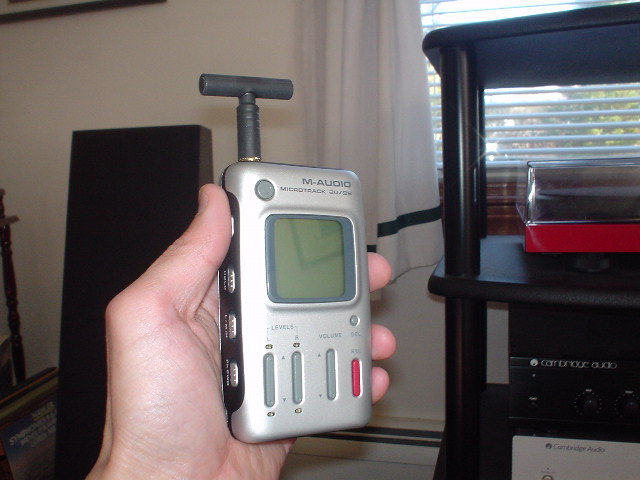 Those Microtrack Mics are Stylin'!
In a strange turn of events, though, those cheap-looking mics actually yielded the best sound, if only by a small margin.
It has the most laid back sound, and has the least amount of grain. If you care sound quality and absolutely must use
the on-board mics, the Microtrack is the one to get.
On to the Edirol R-09. The sound is a step down from the Microtrack. It's harsher and grainier, and if you put its audio
through a good system, you will hear some low level noise. It sounds like faint hiss. I know two people who own these
Edirol R-09s, and both of them complain about its sound quality. While the sound (with the supplied mics, at least) leaves
something to be desired, I should point out for fairness's sake that 1) Both of these guys are serious audiophiles, and 2)
The Zoom does it too. Still, this is not serious, quality sound. While running the level checks, I wound up making nine
different test tracks for each of the three devices. That's a lot of tracks. But I got to the point where I could identify
an Edirol's internal mic recording without looking at the screen.
The Zoom has four mics and will record in surround sound, but I only used it in stereo mode. The H2's mics throw up an
aggressive, up-front sound that you might find exciting (if you like it) or fatiguing (if you don't.) It's the opposite of the
sound produced by the Microtrack's mics. It's a forward sound, kind of like the Edirol's, but it's slightly smoother. Still,
I would not rate this as serious audio.
Results, External Mics
M-Audio Microtrack, Neumann Mics
Edirol R-09, Neumann Mics
Zoom H2, Neumann Mics
Ah, much better! The sound on all three units improved markedly. The audio became smoother, less harsh, and easier to listen
to. The noise floor on all three devices dropped considerably also. If you are picky about audio quality, this is definitely
the way to go. Having said this, certain trends again emerged.
The Microtrack wins. The M-Audio's sound is the most open, smooth, grain-free, natural, and unforced. Again, listen to the
second half of the track. The high notes are the smoothest and most open of the three.
The Edirol's sound gets the "most improved" award. The sound quality takes a huge leap from that of its internal mics. I
suspect that what we have here is a decent set of A/D converters, mated to a cheap set of internal condensor mics.
By the way, both the Edirol and Zoom line inputs impart a weird kind of phasey distortion (can you hear it too?); it's almost
as if the circuitry inside both of them accidentally invert polarity somewhere.
Those Microtrack Mics are Stylin'!
In a strange turn of events, though, those cheap-looking mics actually yielded the best sound, if only by a small margin.
It has the most laid back sound, and has the least amount of grain. If you care sound quality and absolutely must use
the on-board mics, the Microtrack is the one to get.
On to the Edirol R-09. The sound is a step down from the Microtrack. It's harsher and grainier, and if you put its audio
through a good system, you will hear some low level noise. It sounds like faint hiss. I know two people who own these
Edirol R-09s, and both of them complain about its sound quality. While the sound (with the supplied mics, at least) leaves
something to be desired, I should point out for fairness's sake that 1) Both of these guys are serious audiophiles, and 2)
The Zoom does it too. Still, this is not serious, quality sound. While running the level checks, I wound up making nine
different test tracks for each of the three devices. That's a lot of tracks. But I got to the point where I could identify
an Edirol's internal mic recording without looking at the screen.
The Zoom has four mics and will record in surround sound, but I only used it in stereo mode. The H2's mics throw up an
aggressive, up-front sound that you might find exciting (if you like it) or fatiguing (if you don't.) It's the opposite of the
sound produced by the Microtrack's mics. It's a forward sound, kind of like the Edirol's, but it's slightly smoother. Still,
I would not rate this as serious audio.
Results, External Mics
M-Audio Microtrack, Neumann Mics
Edirol R-09, Neumann Mics
Zoom H2, Neumann Mics
Ah, much better! The sound on all three units improved markedly. The audio became smoother, less harsh, and easier to listen
to. The noise floor on all three devices dropped considerably also. If you are picky about audio quality, this is definitely
the way to go. Having said this, certain trends again emerged.
The Microtrack wins. The M-Audio's sound is the most open, smooth, grain-free, natural, and unforced. Again, listen to the
second half of the track. The high notes are the smoothest and most open of the three.
The Edirol's sound gets the "most improved" award. The sound quality takes a huge leap from that of its internal mics. I
suspect that what we have here is a decent set of A/D converters, mated to a cheap set of internal condensor mics.
By the way, both the Edirol and Zoom line inputs impart a weird kind of phasey distortion (can you hear it too?); it's almost
as if the circuitry inside both of them accidentally invert polarity somewhere.
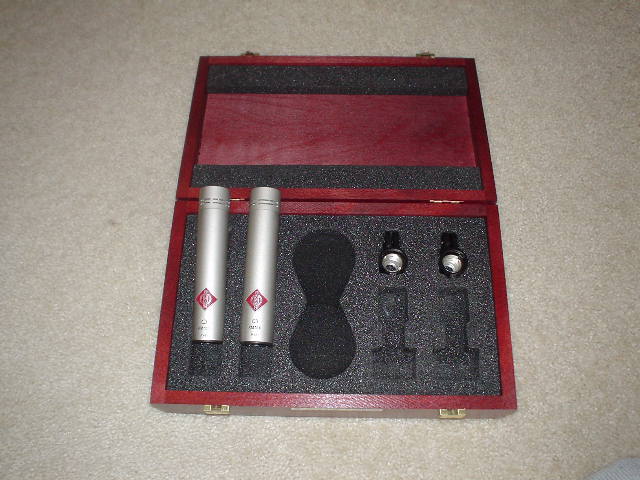 The Neumann KM184 Mics
And the Zoom? Its sound improved with the Neumann's also, but it retains the forward, aggressive quality. While I found this
quality a little charming with its internal mics, it started to grate on me here. Note that the Zoom's line-in inputs are
set very "hot." The levels are quite high, and I had to reset it down almost 20% to match the levels of the other two devices.
I noticed this once before, when I was helping someone transfer an LP to the Zoom. I didn't set the record levels and the
album's sound came out loud and distorted.
So, call it an easy win for the Microtrack, followed at some distance by the Edirol, and then the Zoom.
Conclusions
The Microtrack is the one to get if audio quality is important. Its subjective audio tests routinely beat those of the
Edirol's and the Zoom's. For best results, use the line in inputs and a pair of high quality mics and mic preamps. The
Microtrack is the one with the most legitimate claim towards high-end audio status. It's easy to use, well made, and
has the most serious input and output jacks. But it costs the most, and its non replaceable battery is definitely a
minus.
The Zoom dons an amazing array of features and accessories for very little money. Based on its features and price alone,
it is worth owning. It also sounds decent (especially through its line in inputs) though I think you'll get better absolute
quality through the Microtrack. If you want to do the most for the least amount of money, it's recommended.
The Edirol was a tale of two devices. Its internal mics left a lot to be desired, but the sound quality through its line
input jack was quite listenable. Its ultimate sound quality was slightly higher than the Zoom's. Also, it's an easy
and intuitive device to use.
Having said all of this, I should point out that the differences between the devices, while audible, are small. Used
judiciously, any of them will provide satisfactory performance. Case in point: I was asked to record a piano recital
at a friend's house. It was a last minute notice and the only recorder available was the Edirol. It was the most
demanding type of recording imaginable - live, close-mic'd acoustic classical music with a huge dynamic range.
We went with the line inputs. The mics were Audio Technica's new AT2020 (superb value for the money by the way) and
a cheap Behringer mixer. The R-09 made a fine showing for itself and I haven't heard any complaints from the people
who heard the recording later. As with telescopes, we sometimes get wrapped up with the equipment, instead of the
message.
And boy, have we come a long way since those days in the 1970s when I was holding a microphone up to the TV to record
Star Trek on cassette!
Happy recording to you all,
-Ed
The Neumann KM184 Mics
And the Zoom? Its sound improved with the Neumann's also, but it retains the forward, aggressive quality. While I found this
quality a little charming with its internal mics, it started to grate on me here. Note that the Zoom's line-in inputs are
set very "hot." The levels are quite high, and I had to reset it down almost 20% to match the levels of the other two devices.
I noticed this once before, when I was helping someone transfer an LP to the Zoom. I didn't set the record levels and the
album's sound came out loud and distorted.
So, call it an easy win for the Microtrack, followed at some distance by the Edirol, and then the Zoom.
Conclusions
The Microtrack is the one to get if audio quality is important. Its subjective audio tests routinely beat those of the
Edirol's and the Zoom's. For best results, use the line in inputs and a pair of high quality mics and mic preamps. The
Microtrack is the one with the most legitimate claim towards high-end audio status. It's easy to use, well made, and
has the most serious input and output jacks. But it costs the most, and its non replaceable battery is definitely a
minus.
The Zoom dons an amazing array of features and accessories for very little money. Based on its features and price alone,
it is worth owning. It also sounds decent (especially through its line in inputs) though I think you'll get better absolute
quality through the Microtrack. If you want to do the most for the least amount of money, it's recommended.
The Edirol was a tale of two devices. Its internal mics left a lot to be desired, but the sound quality through its line
input jack was quite listenable. Its ultimate sound quality was slightly higher than the Zoom's. Also, it's an easy
and intuitive device to use.
Having said all of this, I should point out that the differences between the devices, while audible, are small. Used
judiciously, any of them will provide satisfactory performance. Case in point: I was asked to record a piano recital
at a friend's house. It was a last minute notice and the only recorder available was the Edirol. It was the most
demanding type of recording imaginable - live, close-mic'd acoustic classical music with a huge dynamic range.
We went with the line inputs. The mics were Audio Technica's new AT2020 (superb value for the money by the way) and
a cheap Behringer mixer. The R-09 made a fine showing for itself and I haven't heard any complaints from the people
who heard the recording later. As with telescopes, we sometimes get wrapped up with the equipment, instead of the
message.
And boy, have we come a long way since those days in the 1970s when I was holding a microphone up to the TV to record
Star Trek on cassette!
Happy recording to you all,
-Ed
Back to Home Page
Back to Piano Home Page
 The M-Audio Microtrack, the Roland Edirol, and the Zoom H2
The M-Audio Microtrack, the Roland Edirol, and the Zoom H2
The M-Audio Microtrack, the Roland Edirol, and the Zoom H2
 M-Audio's Microtrack ($399 street)
M-Audio's Microtrack ($399 street) Roland's Edirol R-09 ($299 street)
Roland's Edirol R-09 ($299 street) The Do-Everything Zoom H2 ($199 street)
The Do-Everything Zoom H2 ($199 street)
 Those Microtrack Mics are Stylin'!
Those Microtrack Mics are Stylin'! The Neumann KM184 Mics
The Neumann KM184 Mics